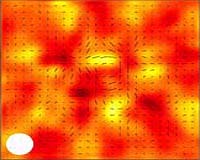 |
| CHANNELS SERVICES press ESCAPE KEY or browser STOP BUTTON to STOP ALL animated GIFS after page has downloaded | 
Spy networks and international financial systems are set to benefit from a significant advance in teleportation technology developed at The Australian National University. ANU researchers in Canberra have announced that they are the first in the world to demonstrate the sharing of secrets via teleportation using quantum physics. The research has potential to significantly enhance the security of computer systems around the world. The researchers provided a window on the future of telecommunications by demonstrating the production, disembodiment and successful reconstruction -- or teleportation -- of a message to a network of participants. The experiment was conducted by 24-year-old PhD student Andrew Lance and Dr Thomas Symul from the Quantum Optics Group in the ANU Faculty of Science, in collaboration with Professor Barry Sanders from the University of Calgary in Canada. The research, published in the latest edition of Physical Review Letters, is expected to attract attention from defence and finance industries around the world. It builds on the teleportation work conducted by Dr Warwick Bowen and Dr Ping Koy Lam at the ANU in 2002, when they teleported information using a laser beam. "This is a much more complex form of information teleportation in the sense that it involves multiple recipients," Dr Lam said. Acting ANU Vice-Chancellor Professor Lawrence Cram congratulated the team on their success. "This research confirms that ANU and Australia are among the World's leaders in teleportation research. It is also a fine example of the excellence achieved through The Australian National University's unique research-driven education program," Professor Cram said. The researchers used crystals, lenses and mirrors to produce a pair of 'entangled' laser beams that are then used to carry fragile information in the form of quantum states. These quantum states cannot be measured or copied, making eavesdropping impossible. The transmission of the light beams constitutes a secret communication scheme with guaranteed security. The process of secret sharing is a fundamental part of present day telecommunication, computer and banking practices. Such network communication can be enhanced using the laws of quantum physics to protect the information -- a process called quantum state sharing. "The benefit of this technology is that the encrypted message can only be decoded by a majority of recipients. For example, if an encrypted message was sent to a spy network containing 15 individuals, a minimum of eight agents would be needed to access the message -- limiting the chances of the message being infiltrated or deleted by a double-agent," Mr Lance said. "The system could also have major applications as a fail-safe mechanism in operating systems for the new generation of super-fast quantum computers." Barry Sanders, iCORE Professor and Director of the newly launched Institute for Quantum Information Science at the University of Calgary, said; "Security is crucial for quantum networks that may someday deliver ultrafast solutions to certain computational problems and for communication that is impervious to eavesdroppers. Our experiment demonstrates that quantum networks can be protected from component failures and malice." There is currently a huge concentration of scientific effort to use quantum physics -- a field in which researchers analyse the realms of the microscopic world where classical physics no longer applies -- in order to create a new generation of technologies including information teleportation. "Teleportation of information has potential to improve the efficiency and security of future quantum computing and communication networks," Dr Symul said. Related Links Australian National University SpaceDaily Search SpaceDaily Subscribe To SpaceDaily Express  Durham - Apr 28, 2004
Durham - Apr 28, 2004In the community of very tiny particles that make up all matter in the universe, there are two main citizens: bosons and fermions. Bosons are socially oriented and tend to stick together, while fermions are solitary entities, preferring to go it alone.   press ESCAPE KEY or browser STOP BUTTON to STOP ALL animated GIFS after page has downloaded June 10, 2004  |


Primordial Pains: How Earth Got Hot? Stanford CA (SPX) Jun 07, 2004  If
a time machine could take us back 4.6 billion years to the Earth's
birth, we'd see our sun shining 20 to 25 percent less brightly than
today. Without an earthly greenhouse to trap the sun's energy and warm
the atmosphere, our world would be a spinning ball of ice. Life may
never have evolved. If
a time machine could take us back 4.6 billion years to the Earth's
birth, we'd see our sun shining 20 to 25 percent less brightly than
today. Without an earthly greenhouse to trap the sun's energy and warm
the atmosphere, our world would be a spinning ball of ice. Life may
never have evolved.Chasing Martian Dust Devils Moffet Field (SPX) Jun 07, 2004  Mars
has only a faint atmosphere [less than one percent of terrestrial
pressures], yet offers up its history of dust devils as swirling tracks
in a remarkable landscape of wind-swept and carved terrain. These tiny
twisters tend to appear in the middle afternoon on Mars, when solar
heating is maximum and when warm air rises and collides with other
pressure fronts to cause circulation. Mars
has only a faint atmosphere [less than one percent of terrestrial
pressures], yet offers up its history of dust devils as swirling tracks
in a remarkable landscape of wind-swept and carved terrain. These tiny
twisters tend to appear in the middle afternoon on Mars, when solar
heating is maximum and when warm air rises and collides with other
pressure fronts to cause circulation.Device Sorts Microscopic Particles With Speed And Precision Princeton NJ (SPX) Jun 07, 2004  In
a remarkable collaboration between engineers, physicists and
biologists, Princeton scientists have invented a device that rapidly
sorts microscopic particles into extremely fine gradations of sizes,
opening a range of potential uses. In
a remarkable collaboration between engineers, physicists and
biologists, Princeton scientists have invented a device that rapidly
sorts microscopic particles into extremely fine gradations of sizes,
opening a range of potential uses.New Skies Sold For A Billion Dollars The Hague (SPX) Jun 07, 2004  New
Skies Satellites N.V., the global satellite communications company,
today announced that it has signed a definitive agreement for the sale
of the Company to affiliates of The Blackstone Group, a leading private
investment firm, for $956 million in cash, equivalent to approximately
$7.96 per fully diluted share. New
Skies Satellites N.V., the global satellite communications company,
today announced that it has signed a definitive agreement for the sale
of the Company to affiliates of The Blackstone Group, a leading private
investment firm, for $956 million in cash, equivalent to approximately
$7.96 per fully diluted share.CSIRO To Webcast Rare Astronomical Event Canberra (SPX) Jun 07, 2004  On
Tuesday afternoon (June 8), one of the rarest celestial events will
occur – a transit of Venus across the Sun. It will be the first time
since 1882 that this has occurred. On
Tuesday afternoon (June 8), one of the rarest celestial events will
occur – a transit of Venus across the Sun. It will be the first time
since 1882 that this has occurred. |
| The contents herein, unless otherwise known to be public domain, are Copyright 1995-2004 - SpaceDaily. AFP Wire Stories are copyright Agence France-Presse ESA Portal Reports are copyright European Space Agency. Additional copyrights may apply in whole or part to other bona fide parties. Advertising does not imply endorsement, agreement or approval of any opinions, statements or information provided by SpaceDaily on any web page published or hosted by SpaceDaily. Privacy Statement |
